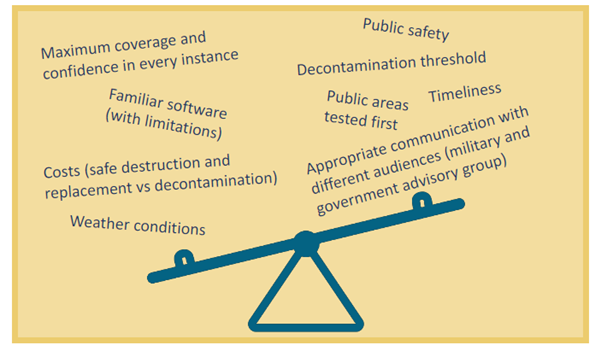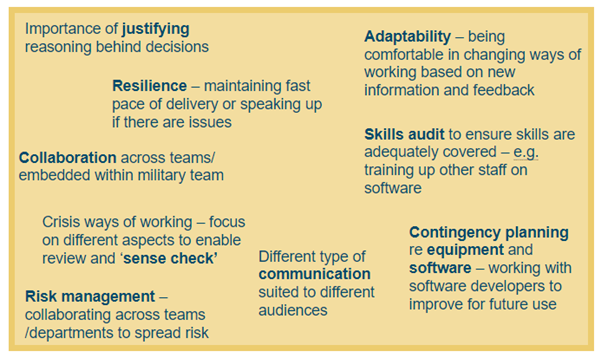Salisbury poisonings and decontamination: is the area safe?

Case study written in collaboration with Victoria Cox, Senior Principal Statistician at the Defence, Science and Technology Laboratory (Dstl).
Summary
In 2018 in Salisbury, England, a nerve agent (Novichok) was used to poison a former Russian military officer (Sergei Skripal) along with his daughter (Yulia Skripal). Statisticians at Dstl – an executive agency sponsored by the Ministry of Defence – led the drawing up of sampling plans to check if areas were clear or needed (further) decontamination.
This case study explores how the statisticians worked under pressure to ensure that the public were safe from harm and to allow public life to return to normal as soon as was safely possible. This involved balancing factors to determine the suitable levels of coverage and confidence for the sampling plans. Due to the number of sites and the disruption to the public, it was essential to only collect as many samples as was necessary to ensure public safety.
What was the problem?
The Salisbury poisonings were a reckless and dangerous act, and efforts had to be made swiftly to trace the poison, establish where the nerve agent had been and decontaminate affected areas in order to keep the public safe.
The statisticians had to decide which areas to sample, how many samples to take, and the exact location of the samples. They needed to be confident that the relevant areas were checked, decontaminated, and then checked again thoroughly.
"It was high-tempo, but we’d had previous experience with the software and fast-paced ops. Everyone was scurrying to get information. We were constantly learning more – we thought we knew where people had been and then we’d find out they’d entered another area, and suddenly we had to put together more plans."
The statisticians had been provided with relevant details from witness statements with details on where witnesses had been, what paths they had taken and what they had touched. The military also provided imagery and measurements from the locations, to aid with sample plan construction, as the statisticians never went on site. Qualified staff with the relevant skills were required, so this task fell to the Dstl statisticians.
What was done?
The statisticians gathered information from witness statements on the routes that had been taken, and used computer software (Visual Sample Plan) to construct the relevant buildings and areas. This sampling software was chosen due to the time pressures and the fact they had prior experience with it – although there were some limitations to its functionality. These limitations were quickly identified and overcome due to their expertise and collaboration with others.
The statisticians included samples along the paths described in the witness statements, incorporating commonly touched places such as doorknobs. They also recommended random sampling, to reach higher levels of coverage and confidence that areas were indeed clear or needed further decontamination.
Areas were to be checked for contamination, decontaminated, and then checked again for any remaining contamination. This cycle was to be repeated until the areas were declared safe. The statisticians had to consider the different levels of coverage and confidence that were suitable for the different stages in this cycle – at first just needing to demonstrate that the nerve agent was present, and later needing to be confident that the area was clean and safe for release.
"We worked every weekend for almost 18 months – we got into a cycle of developing plans ready for sign-off early the following week, so samples could be collected later in the week. We definitely needed resilience and to be able to work closely together. We also had to adapt our communication styles depending on whether we were presenting to DSAG or the military."
They also had to consider when an area would be classified as ‘decontaminated’, and this involved collaboration with the chemical experts. From the statisticians’ point of view, the decision was made to treat the data as binary – needing decontamination versus clear. This made developing sampling plans more straightforward, as there were only two options.
The statisticians presented their plans to the government’s Decontamination Science and Assurance Group (DSAG) for review. The plans were then either given to the military to collect the samples or passed up to ministerial level for final site sign-off once the results had been incorporated into the plans.
What factors were balanced?
From a scientific perspective, it would have been ideal to take as many samples as possible, for maximum coverage and confidence in the results – to be sure that all relevant areas were decontaminated and that public safety was not risked. However, this desire had to be balanced with real-world considerations.
A large amount of resource was involved in terms of workforce, costs, and time. This included deploying military personnel to collect the samples and providing personal protective equipment (PPE) to keep the team on the ground safe. There were limits to how long personnel could effectively wear the extensive PPE – especially in the heat of the summer months, so extra personnel were involved to counter this.
There was also an element of time pressure – with media interest in the incident and pressure to allow public life to return to normal as soon as was safely possible. The statisticians had to consider the impact on the public from restricting access to public areas or homes that may needed to be tested, as well as the impact of damaging property as is often necessary in the process of taking samples. As an example, testing the home of a distant contact could take the form of removing a single discreet sample (eg from under a sofa) or could mean taking many samples, meaning that the home environment would need to be completely replaced – with associated costs to reimburse the damage.
Another area where trade-offs had to be balanced was in the use of software to draw up the sampling plans. There were limitations in the chosen software’s functionality, but the statisticians had previous training in using it and did not have time to research and become familiar with novel software.
A final area where factors had to be balanced was in the communication of the sampling plans. The statisticians had to justify the reasoning behind their choices to DSAG and government for review, but did not need to include overly detailed statistical information. They also needed to communicate the sampling plans clearly to the military – who had quite different needs and simply needed to know where to collect samples. The statisticians put together a single document, which began with the top-level details (eg 3D images of the sampling plan) and then went into further detail for those who needed it.

Infographic illustrating factors that had to be balanced.
What was the impact of these decisions?
"It was all over the news. We kept away from the media, but we had to be very careful about what we could or couldn’t say to family and friends, as we knew more – we were very aware of that."
The statisticians endeavoured to put public safety first – both in terms of avoiding risk of harm, and in terms of limiting disruption to daily life by restricting access to homes and public spaces. They prioritised the order in which environments were tested, leaving the areas they knew would be affected, and were not public places, until last. Their decisions meant that public life could go back to normal as soon as was safely possible.
By seeking to avoid taking more samples than was necessary, the statisticians also avoided wasting resources.
The presentation of the sampling plans and underlying justification enabled the intended audiences (military versus government advisory group) to easily extract the information they needed. Including the reasoning behind the trade-offs meant that decisions were transparent and could be understood.
What are the key learnings?
The statisticians reflected that collaboration was key to understanding how best to work and communicate with the military team. Physically embedding themselves in the same office enabled the statisticians to gain on-the-ground insights that helped inform the sampling plans. One example of this included ensuring that the top-level sampling plans were easily accessible at the start of the briefing packs that were shared with DSAG for review and then passed on to the military.
Another example comes from considering the real-world practicalities of collecting the samples. While the software automatically scattered samples around the room, the statisticians learnt to manually add an efficient sampling route so that the military had a clear path in and out and could therefore collect the necessary samples in the shortest amount of time.
There were just two statisticians working on the sampling plans in this case study, and they had to work closely together. One learning they would recommend for similar scenarios is for each team member to focus on a difference aspect of the work, so the other team member could then review and perform a ‘sanity check’.
Following on from this work, the statisticians began to work with the software developers to address the issues they faced and mitigate them for any future instances where the software is needed. This largely took the form of improving practical rather than statistical aspects. For example, suggesting the functionality to add roofs to buildings, to avoid the statisticians having to use shape blocks as a workaround.
The statisticians have also ensured that additional staff are trained up to be able to use the software, as constructing designs was one of the most time-consuming aspects of the work. This solution means that team members could aid the statisticians’ work in a crisis, and provide resilience in times of need.

Infographic illustrating key learnings.
© Crown copyright (2024), Dstl. This information is licensed under the Open Government Licence v3.0. To view this licence, visit https://www.nationalarchives.gov.uk/doc/open-government-licence/  . Where we have identified any third party copyright information you will need to obtain permission from the copyright holders concerned. Any enquiries regarding this publication should be sent to: Dstl.
. Where we have identified any third party copyright information you will need to obtain permission from the copyright holders concerned. Any enquiries regarding this publication should be sent to: Dstl.